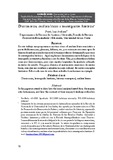Mostrar el registro sencillo del ítem
Diccionarios, análisis léxico e investigación histórica
| dc.rights.license | http://creativecommons.org/licenses/by-nc-sa/3.0/ve/ | es_VE |
| dc.contributor.author | Arellano, Frank José | |
| dc.date.accessioned | 2020-03-19T19:58:41Z | |
| dc.date.available | 2020-03-19T19:58:41Z | |
| dc.date.issued | 2020 | |
| dc.identifier.issn | 1856-9927 | |
| dc.identifier.uri | http://www.saber.ula.ve/handle/123456789/46676 | |
| dc.description.abstract | En este trabajo nos proponemos mostrar cómo el análisis léxico-semántico a partir de diccionarios, glosarios, ficheros, etc., y su contraste con otros tipos de fuentes de información documental se tornan útiles en determinados procesos de investigación histórica. Aquí empleamos herramientas metodológicas de la lexicografía contrastiva y diacrónica con dos fines. Uno, para identificar y definir cosas que desconocemos, pero cuyo registro lingüístico ha quedado reflejado en textos de antaño. Dos, para observar el movimiento semántico de ciertas voces, cosa que nos conduce a aquilatar la carga cultural de ciertos conceptos históricos. Sobre cada uno de estos fines referidos brindaremos un ejemplo. | es_VE |
| dc.language.iso | es | es_VE |
| dc.publisher | SaberULA | es_VE |
| dc.rights | info:eu-repo/semantics/openAccess | es_VE |
| dc.subject | Diccionario | es_VE |
| dc.subject | Lexicografía histórica | es_VE |
| dc.subject | Historia conceptual | es_VE |
| dc.subject | Análisis léxico | es_VE |
| dc.title | Diccionarios, análisis léxico e investigación histórica | es_VE |
| dc.title.alternative | Dictionaries, lexical analysis and historical research | es_VE |
| dc.type | info:eu-repo/semantics/article | es_VE |
| dcterms.dateAccepted | 04-05-2018 | |
| dcterms.dateSubmitted | 19-07-2018 | |
| dc.description.abstract1 | In this paper we intend to show how the lexical analysis derived from the inquiry into dictionaries, and how the contrast of these inquiry’s findings with other documentary sources, become useful methodological processes for a historical research. Here we employ the methods of historical and contrastive lexicography in order to reach two ends. First, we use the dictionaries to identify artifacts and define words unknown to us. Second, we observe the semantic change of terms registered in historical documents. This leads us to assay the cultural weight of such historical concepts. In this article we provide one example for each one of these cases. | es_VE |
| dc.description.colacion | 58-84 | es_VE |
| dc.description.email | frank.arellano@ula.ve | es_VE |
| dc.description.frecuencia | Anual | |
| dc.identifier.depositolegal | PP200908ME20 | |
| dc.publisher.pais | Venezuela | es_VE |
| dc.subject.centroinvestigacion | Centro de Investigaciones en Ciencias Humanas (HUMANIC) | |
| dc.subject.centroinvestigacion | Grupo de Investigaciones sobre Historia de las Ideas en América Latina (GRHIAL) | |
| dc.subject.facultad | Facultad de Humanidades y Educación | es_VE |
| dc.subject.institucion | Universidad de Los Andes | es_VE |
| dc.subject.keywords | Dictionary | es_VE |
| dc.subject.keywords | Historical lexicography | es_VE |
| dc.subject.keywords | Conceptual history | es_VE |
| dc.subject.keywords | lexical analysis | es_VE |
| dc.subject.seccion | Anuario GRHIAL: Artículos científicos (Heterográficos) | es_VE |
| dc.subject.tipo | Revistas | es_VE |
| dc.type.media | Texto | es_VE |
Ficheros en el ítem
Este ítem aparece en la(s) siguiente(s) colección(ones)
-
Anuario GRHIAL Año 012 - Nº 012
Enero - Diciembre 2018


